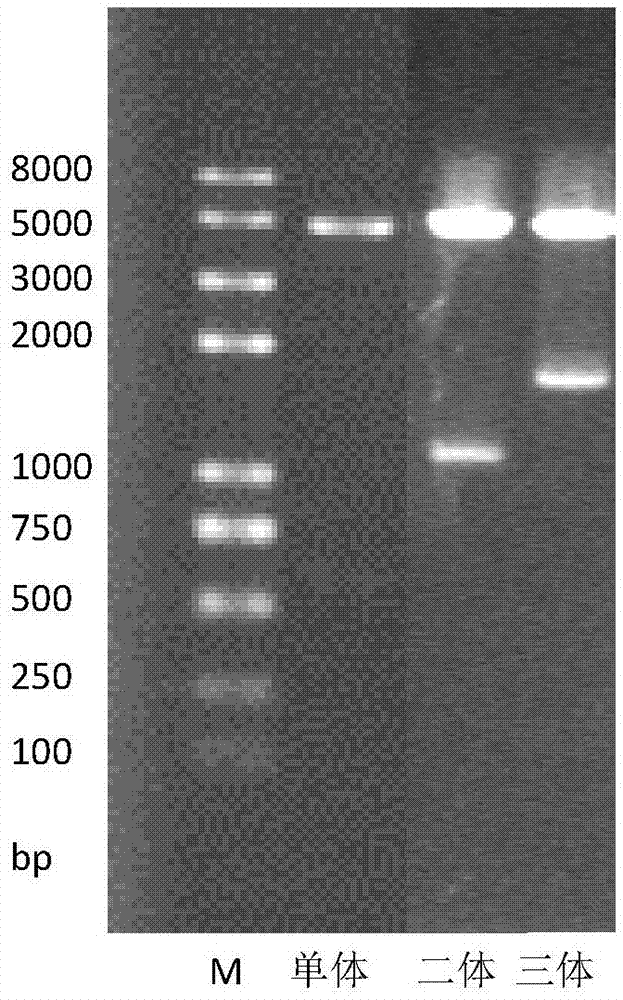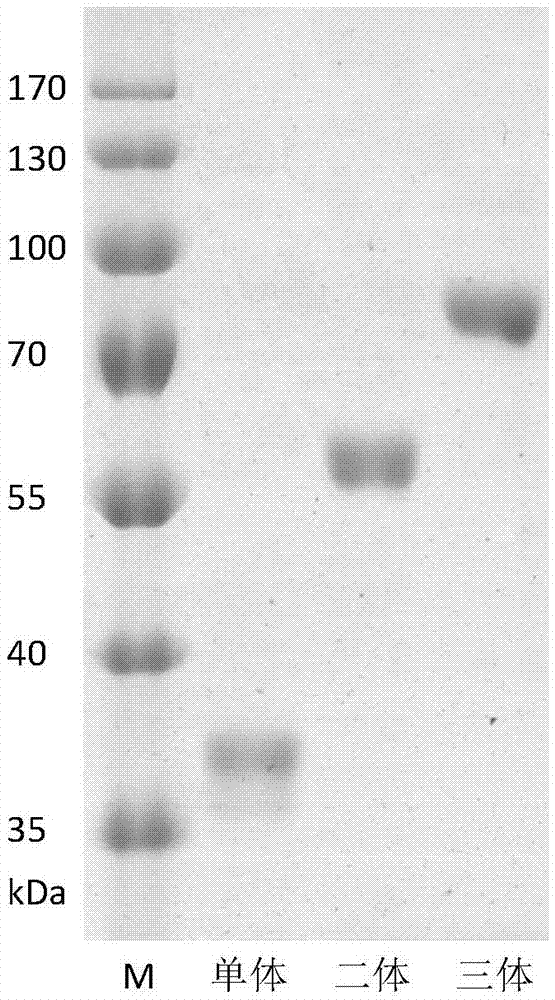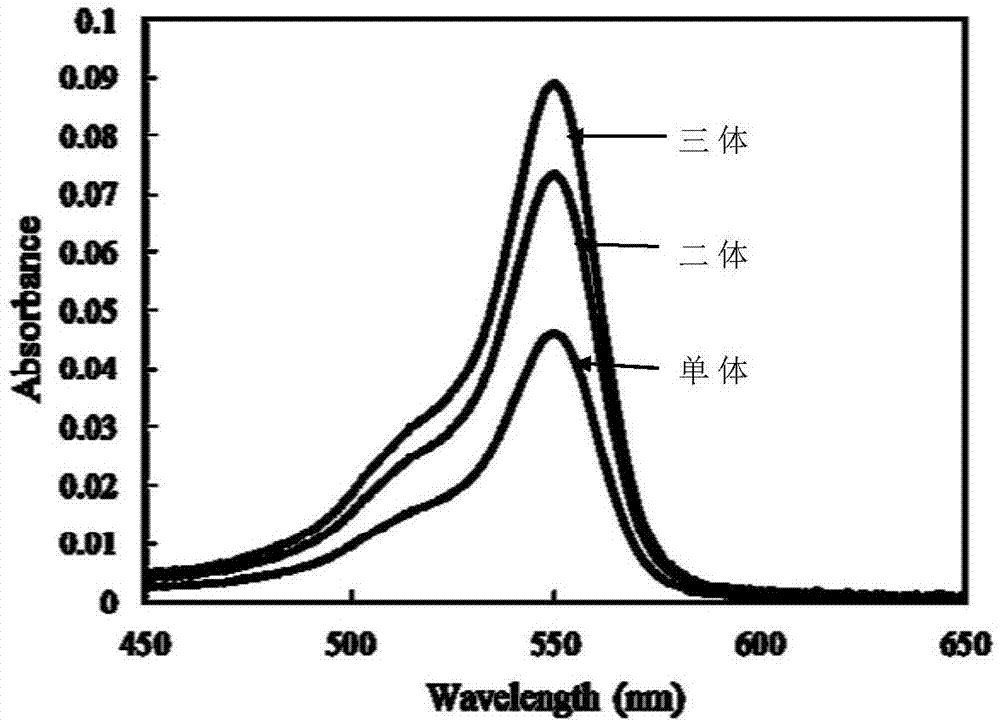Preparation method of high fluorescence intensity recombinant phycobiliprotein concatermer
A technology of phycobiliprotein and fluorescence intensity, which is applied in biochemical equipment and methods, recombinant DNA technology, chemical instruments and methods, etc., can solve the problems of low fluorescence quantum efficiency, low fluorescence intensity, and limited enhancement of fluorescence intensity, and achieve improved Fluorescence intensity, strong fluorescence signal, low cost effect
- Summary
- Abstract
- Description
- Claims
- Application Information
AI Technical Summary
Problems solved by technology
Method used
Image
Examples
Embodiment 1
[0028] 1. Cloning of genes
[0029] The genes of Synechococcus elongatus BP-1 apcA, Synechocytis sp. PCC 6803 Ho1, Prochlorococcus phage P-SSM2 pebS, Synechococcus elongatus BP-1 cpcS and streptavidin were obtained from the National Center for Biotechnology Information (NCBI) database SA sequence (Accession No. X65082). Therefore, specific primers for amplifying apcA, Ho1, and cpcS were designed respectively (Table 1). Genomic DNA of Synechococcus elongatus BP-1 was used as a template for apcA gene, Genomic DNA of Synechocytissp. The SA gene and linker sequence were artificially synthesized by Nanjing GenScript Biotechnology Co., Ltd. In order to facilitate the fusion PCR reaction, during the artificial synthesis of the linker sequence, partial sequences of the SA gene and the apcA gene were added to its 5' end and 3' end, respectively.
[0030] 2. Construction of recombinant plasmids
[0031] 2.1 Fusion (monomer) of streptavidin gene and allophycocyanin α subunit gene and...
Embodiment 2
[0053] 1. Cloning of genes
[0054] Genes of Synechococcus elongatus BP-1 apcA, Synechocytis sp. PCC 6803 Ho1, Prochlorococcus phage P-SSM2 pebS, Synechococcus elongatus BP-1 cpcS and streptavidin were obtained from the National Center for Biotechnology Information (NCBI) database SA sequence (Accession No. X65082). Therefore, specific primers for amplifying apcA, Ho1, and cpcS were designed respectively (Table 1). Genomic DNA of Synechococcus elongatus BP-1 was used as template for apcA gene, genomic DNA of Synechocytissp.PCC 6803 was used as template for Ho1, and genomic DNA of Synechococcus elongatus BP-1 was used as template for cpcS gene. The SA gene and linker sequence were artificially synthesized by Nanjing GenScript Biotechnology Co., Ltd. In order to facilitate the fusion PCR reaction, during the artificial synthesis of the linker sequence, partial sequences of the SA gene and the apcA gene were added to its 5' end and 3' end, respectively.
[0055] 2. Constructio...
Embodiment 3
[0078] 1. Cloning of genes
[0079] Genes of Synechococcus elongatus BP-1 apcA, Synechocytis sp. PCC 6803 Ho1, Prochlorococcus phage P-SSM2 pebS, Synechococcus elongatus BP-1 cpcS and streptavidin were obtained from the National Center for Biotechnology Information (NCBI) database SA sequence (Accession No. X65082). Therefore, specific primers for amplifying apcA, Ho1, and cpcS were designed respectively (Table 1). Genomic DNA of Synechococcus elongatus BP-1 was used as template for apcA gene, genomic DNA of Synechocytissp.PCC 6803 was used as template for Ho1, and genomic DNA of Synechococcus elongatus BP-1 was used as template for cpcS gene. The SA gene and linker sequence were artificially synthesized by Nanjing GenScript Biotechnology Co., Ltd. In order to facilitate the fusion PCR reaction, during the artificial synthesis of the linker sequence, partial sequences of the SA gene and the apcA gene were added to its 5' end and 3' end, respectively.
[0080] 2. Constructio...
PUM
 Login to View More
Login to View More Abstract
Description
Claims
Application Information
 Login to View More
Login to View More - R&D
- Intellectual Property
- Life Sciences
- Materials
- Tech Scout
- Unparalleled Data Quality
- Higher Quality Content
- 60% Fewer Hallucinations
Browse by: Latest US Patents, China's latest patents, Technical Efficacy Thesaurus, Application Domain, Technology Topic, Popular Technical Reports.
© 2025 PatSnap. All rights reserved.Legal|Privacy policy|Modern Slavery Act Transparency Statement|Sitemap|About US| Contact US: help@patsnap.com



